Tractors for Home and Abroad.
Page 14
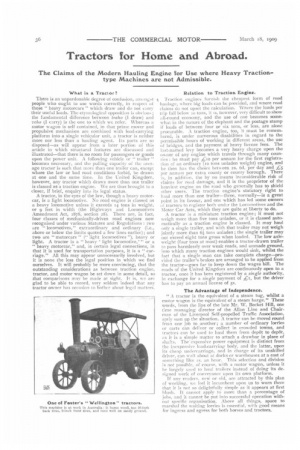
Page 15
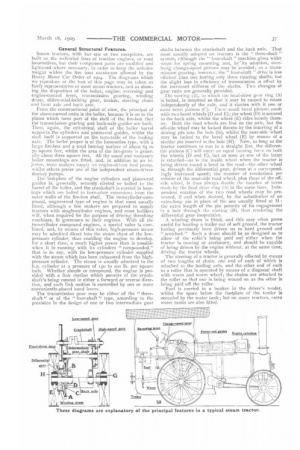
Page 16
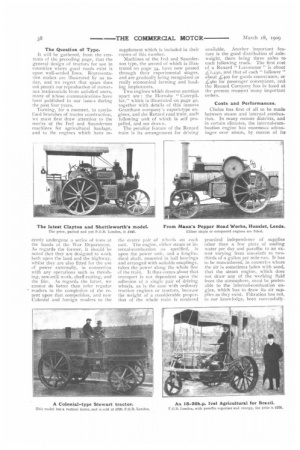
Page 17
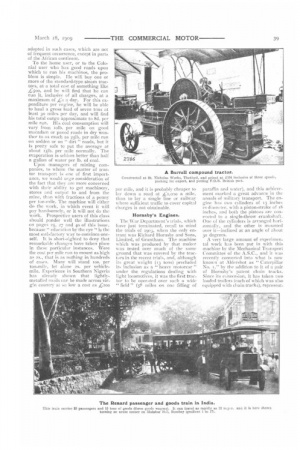
Page 18
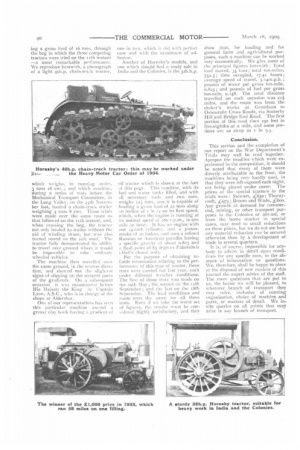
If you've noticed an error in this article please click here to report it so we can fix it.
The Claims of the Modern Hauling Engine for Use where Heavy Traction.type Machines are not Admissible.
What is a Tractor 7
There is an unpardonable degree of confusion, amongst people who ought to use words correctly, in respect of those " heavy motorcars " which draw and do not carry their useful loads. The etymological opposition is obvious; the fundamental difference between traho (I draw) and veho tI carry) is the one to which we refer. Whereas a motor wagon is self contained, in that prime mover and propulsive mechanism are combined with load-carrying platform into a single vehicular unit, a tractor is neither more nor less than a hauling agent. Its parts are so disposed—as will appear from a later portion of this article in which structural features are discussed and illustrated—that there is no room for passengers or goods upon the power unit. A following vehicle or "trailer " becomes necessary, and the pulling capacity of the average tractor is such that more than one trailer can, except where the law or bad road conditions forbid, be drawn at one and the same time. In the United Kingdom, however, any tractor which draws more than one trailer is classed as a traction engine. We are thus brought to a closer, if brief, enquiry into its legal status.
A tractor, in the eyes of the law, though a heavy motorcar, is a light locomotive. No road engine is classed as a heavy locomotive unless it exceeds 14 tons in weight, or 9 feet in width (the Highways and Locomotives Amendment Act, 1878, section 28). There are, in fact, four classes of mechanically-driven road engines now recognised under various Statutes and Regulations : two are "locomotives," extraordinary and ordinary (i.e., above or below the limits quoted a few lines earlier); and two are "motorcars " (" light locomotives "), heavy or light. A tractor is a "heavy 'light locomotive,'" or a " heavy motorcar," and, in certain legal connections, in that it is used for transportation purposes, it is a "carriage." All this may appear unnecessarily involved, but it is none the less the legal position in which we find ourselves. It will probably be more convincing, that the outstanding considerations as between traction engine, tractor, and motor wagon be set down in some detail, so that comparisons may be made at sight. It is, we are glad to be able to record, very seldom indeed that any tractor owner has occasion In hothcr about legal matters. Relation to Traction Engine.
A Traction engines furnish the cheapest form of road haulage, where big loads can be provided, and wnere road claims do not upset the calculation. Where the loads per trip fall below 10 tons, it is, however, very difficult to show all-round economy, and the use of one becomes somewhat in the nature of the elephant and the postage stamp if loads of between four or six tons, or less, are alone procurable. A traction engine, too, it must be remembered, is under numerous disabilities in regard to the permissible hours of working in different areas, the use of bridges, and the payment of heavy license fees. The last-named levy becomes a very heavy charge upon the owner of any engine which travels through many counties : he must pay Lio per annum for the first registration of an ordinary (to tons unladen weight) engine, and he then has the choice between 2S. 6d. per day and per annum per extra county or county borough. There is, in addition, the by no means inconsiderable risk of claims for road damage, and it is the proprietor of the heaviest engine on the road who generally has to shield other users. The traction engine's statutory right to haul more than one trailer—three, normally—is a great point in its favour, and one which has led some owners of tractors to register both unclir the Locomotives and the Motor Car Acts, which they are quite at liberty to do. A tractor is a miniature traction engine; it must not weigh more than five tons unladen, or it is classed automatically as a traction engine is classed. It may haul only a single trailer, and with that trailer may not weigh jointly more than 6i tons unladen ; the single trailer may not exceed eight tons gross when loaded. The low axle.. weight (four tons at most) enables a tractor-drawn trailer to pass harmlessly over weak roads, and unmade ground, into which many traction engines would sink, whilst the fact that a single man can take complete charge—provided the trailer's brakes are arranged to be applied from the tractor—goes far to keep down the wages bill. The roads of the United Kingdom are continuously open to a tractor, once it has been registered by a single authority, in exchange for a single payment of but the driver has to pay an annual license of 5s,
The Advantage of Independence.
" A tractor is the equivalent of a steam tug, whilst a motor wagon is the equivalent of a steam barge." These words, from the lips of the late Mr. W. Becket Hill, one time managing director of the Allan Line and Chairman of the Liverpool Self-propelled Traffic Association, aptly sum up the situation. A tractor can be moved round from one job to another ; a number of ordinary lorries or carts can deliver or collect in crowded towns, and tractors can be used to haul them from depot to depot, as it is a simple matter to attach a drawbar in place of shafts. The expensive power equipment is distinct from the inexpensive load-carrying body, and the latter, upon its cheap undercarriage, and in charge of its unskilled driver, can wait about at docks or warehouses at a cost of something like is. an hour. This selection and division k not possible, of course, with a motor wagon, unless it be largely used to haul trailers instead of doing its designed work of conveyance upon its own platform. If any readers, new or oh 1, are attracted by this plan of working, we feel it incumbent upon us to warn them that it is not so delightfully simple as it appears at first blush. It cannot apply to more than a percentage of jobs, and it cannot be put into successful operation with-out specific organisation. Above all things, space to marshal the waiting lorries is essential, with good means for ingress and egress for both horses and tractors.
General Structural Features.
• Steam tractors, with but one or two exceptions, are built on the well-tried lines of traction engines, or road locomotives, but their component parts are modified and lightened where necessary, in order to keep the unladen weight within the five tons maximum allowed by the Heavy Motor Car Order of 1904. The diagrams which we reproduce at the foot of this page may he taken as fairly representative of most steam tractors, and as showing the disposition of the boiler, engine, reversing and engine-control lever, transmission gearing, winding drum, diflerential-locking gear, brakes, steering chain and front axle and hack axle.
From the constructional point of view, the principal of the above-named units is the boiler, because it is on to the plates which form part of the shell of the fire-box that the transmission gearing and back-axle guides are built. Then, again, the cylindrical shell of the boiler barrel supports the cylinders and piston-rod guides, whilst the shell itself is supported on the turn-table of the leading axle. The. boiler proper is of the locomotive type, with a large fire-box and a total heating surface of about 65 to 70 square feet, whilst the area of the fire-grate is generally about three square feet. All the usual and necessary boiler mountings are fitted, and, in addition to an injector, some makers supply an engine-driven feed pump, whilst others prefer one of the independent steam-driven donkey pumps.
The bed-plate of the engine cylinders and piston-rod guides is, generally, securely riveted or bolted to the barrel of the boiler, and the crankshaft is carried in bearings which are bolted to horn-plate extensions from the outer walls of the fire-box shell. The two-cylinder-compound, ungoverned type of engine is that most usually fitted, although a few makers are prepared to supply tractors with single-cylinder engines, and most builders will, when required for the purpose of driving threshing machines, fit governors to their engines. With all the two-cylinder compound engines, a special valve is combined, and, by means of this valve, high-pressure steam may be admitted direct into the steam .chest of the lowpressure cylinder, thus enabling the engine to develop, for a short time, a much higher power than is possible when it is running with its cylinders " compounded," that is to say, with its low-pressure cylinder supplied with the steam which has been exhausted from the highpressure cylinder. The steam is usually admitted to the h.p. cylinder at a pressure of iso to zoo lb. per square inch. Whether simple or compound, the engine is provided with a link motion which permits of the crankshaft's being rotated in either a forward or reverse direction, and such link motion is controlled by one or more conveniently-placed hand levers,
The transmission gear may be either of the " threeshaft" or of the " four-shaft " type, .aecording to the provision in the design of one or two intermediate gear shafts between the crankshaft and the back axle. That most usually adopted on tractors is the " three-shaft " system, rithough the " four-shaft " machine gives wider scope fat spring mounting and, by 'its adoption, overhung change-speed pinions may be avoided; as a transmission gearing, however, the " four-shaft " drive is less efficient than one having only three rotating shafts, but the slight loss in efficiency of transmission is offset. by the increased stiffness of the shafts. Two changes of gear ratio are generally provided.
The casting (If), to which the final-drive gear ring (A) is bolted, is mounted so that it may be caused to rotate independently of the axle, and it carries with it one or more bevel pinions (C). These small bevel pinions mesh with two bevel wheels (D and E); the wheel (D) is secured to the back axle, whilst the wheel (E) rides loosely thereon. Both the road wheels are free on the axle, but the off-side wheel may he locked thereto by the inserting of a driving pin into the hole (G), whilst the near-side wheel may be locked to the bevel wheel (E) by means of a similar pin inserted in the hole (H). Now, so long as the tractor continues to run in a straight line, the differential pinions (C) will exert an equal turning force on bath the wheels (D and E), but as soon as one of the latter is retarded—as is the inside wheel when the tractor is being driven round a bend in the road—the other wheel is, through the differential gear, driven at a correspondingly increased speed; the number of revolutions per minute of the near-side road wheel, plus those of the offside wheel, is thus always double the number of turns made by the final drive ring (Al in the same time. independent rotation of the two road wheels may be prevented, if and when desired, by the substitution of an extra-long pin in place of the one usually fitted at H : the extra length of the pin permits of its engagement Pi a hole through the casting (B), thus rendering the differential gear inoperative.
A winding drum is fitted, and this may often prove useful for hauling a trailer out of soft ground, the tractor having previously been driven on to hard ground and " scotched." Such a drum should be so designed as to allow of the cable's being paid out either when the tractor is moving or stationary, and Should be capable of being driven by the engine without, at the same time, driving the tractor wheels.
The steering of a tractor is generally effected by means of two lengths of chain, one end of each of which is attached to the leading axle, and the other end of each to a roller that is operated by means of a diagonal shaft with worm and worm wheel; the chains are attached to the roller so that one is being wound on as the other is being paid off the roller. Fuel is carried in a bunker in the driver's tender, whilst the space below the footplate of the tender is occupied by the water tank; but on many tractors, extra water tanks are also fitted.
The Question of Type.
It will be gathered, from the contents of the preceding page, that the general design of tractors for use in countries where good roads exist is upon well-settled lines. Representative makes are illustrated by us today, and we regret that space does not permit our reproduction of nurnerOUS testimonials from satisfied users, many of whose communications have been published in our issues during the past four years.
Turning, for a moment, to specialised branches of tractor construction, we must first draw attention to the merits of the Ivel and Saunderson machines for agricultural haulage, and to the engines which have re
centiv undergone a series of tests at the hands of the War Department. As regards the former, it should be noted that they are designed to work both upon the land and the highway, whilst they are also fitted for the use of power externally, in connection with any operations such as threshing, saw-mill work, chaff cutting, and the like. As regards the latter, w.e Cannot do better than refer regular readers to the completion of the report upon that competition, and new Colonial and foreign readers to the supplement which is included in their copies of this number_ Machines of the Ivel and Saunderson type, the second of which is illustrated on page 34, have now passed through their experimental stages, and are gradually being recognised as really economical farming and hauling implements.
Two engines which deserve mention apart are : the liornshy " Caterpillar," which is illustrated on page 40, together with details of this famous Grantham company's export-type engines, and the Renard road train, each following unit of which is self propelled, and not drawn.
The peculiar feature of the Renard train is its arrangement for driving
the centre pair of wheels on each unit. The engine, either steam or internal-combustion as specified, is upon the power unit, and a longitudinal shaft, mounted in ball bearings and arranged with suitable couplings, takes the power along the whole line of the train. It thus comes about that transport is not dependent upon the adhesion of a single pair of driving wheels, as is the case with ordinary traction engines or tractors, because the weight of a considerable proportion of the whole train is rendered
available. Another important feature is the good distribution of axleweight, there being three axles to each following truck. The first cost of a Renard " Locomotor " is about 1:1,440, and that of each" follower" about ,Licio for goods conveyance, or -L460 for passenger conveyance, and the Renard Company has in hand at the present moment many important orders.
Costs and Performances.
Choice has first of all to be made between steam and internal combustion. In many remote districts, and in certain climates, the internal-combustion engine has enormous advantages over steam, by reason of it practical independence of supplies other than a few pints of cooling water per day and paraffin to an extent varying from one-sixth to twothirds of a gallon per mile run. It has to be remembered, in countries where the air is sometimes laden with sand; that the steam engine, which does not draw any of the working fluid from the atmosphere, must be preferable to the internal-combustion engine, which has to draw its air supplies as they exist. Filtration has not, to our knowledge, been successfully
adopted in such eases, which are not of frequent occurrence, except in parts of the African continent.
To the home user, or to the Colonial user who has good roads upon which to run his machines, the pro blem is simple. Ile will buy one or more of the standard-type steam trac tors, at a total cost of something like L:500, and he will find that he can run it, inclusive of all charges, at a
maximum of .4.;t a day. For this expenditure per engine, he will be able to haul a gross load of seven tons at least 30 miles per day, and will find his total outgo approximate to 8d. per mile run. His coal consumption wilt vary from iolb, per mile on good macadam or paved roads in dry weather to as much as 2511). per mile run on sodden or on " dirt " roads, but it is pretty safe to put the average at about 151b. per mile normally. The evaporation is seldom better than half a gallon of water per lb. of coal. Upon managers of mining companies, to whom the matter of tractor transport is one of first importance, we would urge consideration of the fact that they are more concerned with their ability to get machinery, stores and output to and from the mine, than with fractions of a penny per ton-mile. The machine will either do the work, in which event it will pay handsomely, or it will not do the work. Prospective users of this class should ponder well the illustrations On pages 25, 27 and 40 of this issue, because" education by the eye "is the most satisfactory way to convince oneself. It is short-sighted to deny that remarkable changes have taken place in these particular instances. Were the cost per mile run to mount as high as 25., that is as nothing in hundreds of cases. Many will stand mos. per ton-mile, let alone 25. per vehiclemile _ Experience in Southern Nigeria has already shown that lightlymetalled roads earl be made across virgin country at No low a cost as £200
per mile, and it is probably cheaper to lay down a road at £i,000 a mile, than to lay a single line or railway where sufficient traffic to cover capital charges is not obtainable.
Hornsby's Engines.
The War Department's trials, which have just terminated, recall to mind the trials of 1903, when the only entrant was Richard Hornsby and Sons, Limited, of Grantham. The machine which was produced by that maker was tested over much of the same ground that was covered by the tractors in the recent trials, and, although its great weight 03 tons) precluded its inclusion as a " heavy motorcar " under the regulations dealing with light locomotives, it was the first tractor to be operated over suA mi wide " field " (5F miles on one filling of
paraffin mid water), and this achievement marked a great advartee in the annals of military transport. The engine has two cylinders of 13 inches in diameter, with a piston-stroke of 18 inches, and both the pistons are connected to a single-throw crankshaft. One of the cylinders is arranged horizontally, and the other is mounted over it—inclined at an angle of about 30 degrees.
A very large amount of experimental work has been put in with this machine by the Mechanical Transport Committee of the A.S.C., and it was recently converted into what is now known at Aldershot as " Caterpillar No. t," by the addition to it of a pair of Hornsby's patent chain tracks. Since its conversion, it has taken two loaded trailers (each of which was also equipped with chain tracks), represent_ ing a gross load of t6 tons, through the bog in which the three competing tractors were tried on the tith instant —a most remarkable perfnrmance. We reproduce herewith, a photograph of a light 4011.p. chain-tra.-k trautor, which weighs, in runniag order, 3 tons 16 cwt.; and which machine, during a series of tests before the Mechanical Transport Committee, in the Long Valley, on the 25th November last, hauled a chain-track trailer weighing 4 tons 8 cwt. Those trials were made over the same route as that followed on the iith instant, and, when crossing the bog, the tractor not only hauled its trailer without the aid of winding drum, but was also turned round on the soft mud. Tho tractor fully demonstrated its ability to travel over ground where it would be itnpossible to take ordinary wheeled vehicles.
The machine then travelled over the same ground, in the reverse direction, and show ed not the slightest signs of slipping on the steepest parts of the gradients. On a subsequent occasion it was manoeuvred before His Majesty the King he Captain Lyon, A.S.C., who is in charge of the shops at Aldershot.
One of our representatives has seen this particular machinc ascend a greasy clay bank having a gradient of one in two, ‘vhich it did with perfect ease and with the maximum of adhesion.
Another of Hornsby's models, and one which should find a ready sale in India and the Colonies, is the 32b.h.p.
oil tractor which is shown at the foot of this page. This machine, with its fuel and water tanks filled, and with all necessary tools and two men, weighs 121 tolls, anti it is capable of hauling a gross load of 22 tons along an incline of i in 12 011 its first speed, which, when the engine is running at its normal speed of 28o r.p.m., is one mile an hour. It has an engine with one 14-inch cylinder, and a pistonstroke of to incites, and uses a refined Russian or American paraffin having a specific gravity of about 0.823 and a flash point of .!.i5 degrees Fahrenheit (Abel's closed test). For the purpose of obtaining reliable information relating to the performance of this type of tractor, three tests were carried out last year, each under different 'weather conditions. The first of those tests was made on the 29th May ; the second on the n ith September ; and the last on the 1Sth September, The load conditions and route were the same for all three tests. Even if we take the worst set of figures, the results must be considered highly satisfactory, and they
show that, for hauling and for general farm and agricultural purposes, such a machine can be worked very economically. We give some of the principal figures herewith : Total load moved, 35 tons ; total ton-miles, 752.5; time occupied, 17.41 hours; average speed of travel, 3.14m.p.h.; pounds of water per gross ton-mile, 0.825; and pounds of fuel per gross o.158. The total distance travelled on each occasion was 21i miles, and the route was from the maker's works at Grantham to Osbournbv Cross Roads, via Somerby Hill and Bridge End Road. The first portion of this road rises 25o feet in five-eighths of a mile, and some portions are as steep as i in Conclusion.
This section and the completion of our report on the War Department's Trials may well be read together. Apropos the troubles which were experienced in the competition, it should be noted that many of them were directly attributable to the frost, the machines being. very hardly used, in that they were left exposed each night, not being placed under cover. The prices of the special tractors in the trials were : Stewart, £65o; Thornycroft, J975; Broom and Wade, fioo. Any growth of demand for commercial, mining, or other transport purposes in the Colonies or abrJad, or from the home market in special cases, may tend to small reductions on these prices, but we do not see how any material reduction can be secured otherwise than by a development of tradein several quarters.
It is, of course, impossible for anybody to advise in detail upoa conditions for any specific case, in the absence of information or questions. NVe, therefore, shall be happy to place at the disposal of new readers of this journal the expert advice of the staff. The more questions that are put to us, the better we will be pleased, to whatever branch of transport they may refer, inclusive of running organisation, choice of machine and parts, or matters of detail. We invite queries on all points that may arise in any branch of transport, .
























